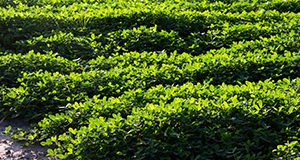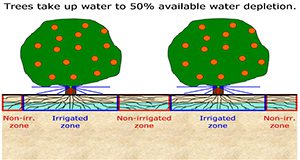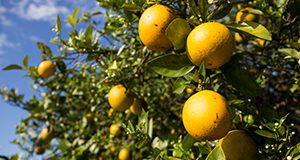Effective irrigation scheduling enables the irrigator to apply the right amount of water at the right time to meet the crop water demand. This 19-page guide presents information on average daily and weekly crop water use and crop growth stages for twelve north Florida crops that can be used to help schedule irrigation. This will allow a grower to develop a realistic irrigation schedule that minimizes plant water stress, saves water, and reduces nutrient leaching potential. Written by Vivek Sharma, Charles Barrett, De Broughton, and Thomas Obreza, and published by the UF/IFAS Department of Soil and Water Sciences, revised December 2020.
https://edis.ifas.ufl.edu/ss491
Tag: Thomas Anthony Obreza
Irrigation Management of HLB-Affected Trees
Water is a limiting factor in Florida citrus production due to non-uniform rainfall distribution and the low water-holding capacity of our sandy soils. Because periods of low rainfall coincide with critical stages of citrus production, additional irrigation is necessary to reduce the negative effects of water stress. This 6-page document covers recent findings on water use of trees affected by citrus greening and the impact this would have on irrigation management considerations. Written by Davie Kadyampakeni, Kelly Morgan, Mongi Zekri, Rhuanito Ferrarezi, Arnold Schumann, and Thomas A. Obreza and published by the UF/IFAS Department of Soil and Water Sciences, October 2017.
http://edis.ifas.ufl.edu/ss659
Citrus Irrigation Management
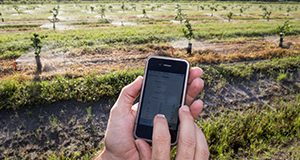 The chapter on irrigation management of citrus is largely taken from guidelines provided in SL253 on trees prior to Huanglongbing (HLB) prevalent conditions. A section has been added to cover recent findings on water use of trees affected by HLB and the impact this would have on the irrigation management considerations. This 6-page fact sheet discusses water supply, allowable soil water depletion, irrigation scheduling, soil moisture measurement, water budgeting, smartphone apps, irrigation strategies to improve nutrient uptake and reduce leaching, and irrigation management considerations for HLB-affected trees. Written by Davie Kadyampakeni, Kelly Morgan, Mongi Zekri, Rhuanito Ferrarezi, Arnold Schumann, and Thomas Obreza, and published by the UF/IFAS Soil and Water Sciences Department, September 2017.
The chapter on irrigation management of citrus is largely taken from guidelines provided in SL253 on trees prior to Huanglongbing (HLB) prevalent conditions. A section has been added to cover recent findings on water use of trees affected by HLB and the impact this would have on the irrigation management considerations. This 6-page fact sheet discusses water supply, allowable soil water depletion, irrigation scheduling, soil moisture measurement, water budgeting, smartphone apps, irrigation strategies to improve nutrient uptake and reduce leaching, and irrigation management considerations for HLB-affected trees. Written by Davie Kadyampakeni, Kelly Morgan, Mongi Zekri, Rhuanito Ferrarezi, Arnold Schumann, and Thomas Obreza, and published by the UF/IFAS Soil and Water Sciences Department, September 2017.
http://edis.ifas.ufl.edu/ss660
Fertigation for Citrus Trees
Microirrigation is an important component of citrus production systems in Florida. For citrus trees, microirrigation is more desirable than other irrigation methods for several reasons: water conservation, fertilizer management efficiency, and freeze protection. Research has shown that when microirrigation systems are properly managed, water savings can amount to as much as 80% compared with subirrigation and 50% compared with overhead sprinkler irrigation. Research has also shown the important advantage of microsprinklers for freeze protection of citrus. This 4-page fact sheet discusses fertilizer solubility and some common fertigation materials. It also offers a fertigation summary. Written by Mongi Zekri, Arnold Schumann, Tripti Vashisth, Davie Kadyampakeni, Kelly Morgan, Brian Boman, and Tom Obreza, and published by the UF Horticultural Sciences Department, September 2017.
http://edis.ifas.ufl.edu/hs1306
Extraction of Soil Nutrients Using Mehlich-3 Reagent for Acid-Mineral Soils of Florida
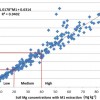 Soil testing is a multistep process starting with the collection of a sample that adequately represents the area or field to be tested. Due to wide-ranging soil conditions across Florida and the United States, multiple soil test methods exist. During the 1970s, Florida along with several other southeastern US states adopted Mehlich-1 (M1) as the official extractant for acidic soils. The UF/IFAS Plant Nutrient Oversight Committee approved the change from M1 to M3 in 2010. Based on observations of the interpretations, the technical committee revised the M3 interpretation in March 2014. The new interpretations have been correlated with the M1 interpretations, as closely and realistically as possible, so the actual nutrient recommendations are not changed. This 7-page fact sheet was written by Rao Mylavarapu, Tom Obreza, Kelly Morgan, George Hochmuth, Vimala Nair, and Alan Wright, and published by the UF Department of Soil and Water Science, May 2014.
Soil testing is a multistep process starting with the collection of a sample that adequately represents the area or field to be tested. Due to wide-ranging soil conditions across Florida and the United States, multiple soil test methods exist. During the 1970s, Florida along with several other southeastern US states adopted Mehlich-1 (M1) as the official extractant for acidic soils. The UF/IFAS Plant Nutrient Oversight Committee approved the change from M1 to M3 in 2010. Based on observations of the interpretations, the technical committee revised the M3 interpretation in March 2014. The new interpretations have been correlated with the M1 interpretations, as closely and realistically as possible, so the actual nutrient recommendations are not changed. This 7-page fact sheet was written by Rao Mylavarapu, Tom Obreza, Kelly Morgan, George Hochmuth, Vimala Nair, and Alan Wright, and published by the UF Department of Soil and Water Science, May 2014.
http://edis.ifas.ufl.edu/ss620
Water Use for Drip-Irrigated Watermelon with Plastic Mulch in Florida
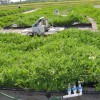 Watermelon is an important crop in Florida and accounts for a significant part of its agricultural water use. Watermelon is grown in open fields and on raised plastic-mulched beds, with the latter being the predominant production system in Florida. Accurate water use estimates for this crop are needed to develop better water allocation and management plans as well as for irrigation management. This publication summarizes the results from a crop water-use study for the drip-irrigated watermelon in south Florida. This 3-page fact sheet was written by Sanjay Shukla, Niroj K. Shrestha, Thomas A. Obreza, and Brian J. Boman, and published by the UF Department of Agricultural and Biological Engineering, August 2014.
Watermelon is an important crop in Florida and accounts for a significant part of its agricultural water use. Watermelon is grown in open fields and on raised plastic-mulched beds, with the latter being the predominant production system in Florida. Accurate water use estimates for this crop are needed to develop better water allocation and management plans as well as for irrigation management. This publication summarizes the results from a crop water-use study for the drip-irrigated watermelon in south Florida. This 3-page fact sheet was written by Sanjay Shukla, Niroj K. Shrestha, Thomas A. Obreza, and Brian J. Boman, and published by the UF Department of Agricultural and Biological Engineering, August 2014.
http://edis.ifas.ufl.edu/ae508
Factors Affecting Phosphorus Leaching and Groundwater Concentrations for the Plasticulture Vegetable-Production System
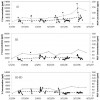 Although Best Management Practices (BMPs) have been developed to reduce the loss of nutrients, like P, to the environment, limited information exists on the main factors that control P loss to Florida groundwater. For example, while it is generally accepted that both irrigation and fertilizer P impact groundwater P, growers often ask if controlling one is more advantageous than the other in their efforts to reduce P leaching. There exists no easy tool to link fertilizer P input and other factors to groundwater P concentration. This 5-page fact sheet uses long-term data (six growing seasons) from a farm in Immokalee, Florida, to explain the effects of soil and agronomic factors, along with seasonal rainfall, on groundwater P. From these factors are derived simple equations to predict groundwater P concentrations. Written by Sanjay Shukla, Gregory S. Hendricks, Thomas A. Obreza, and Willie Harris, and published by the UF Department of Agricultural and Biological Engineering, August 2014.
Although Best Management Practices (BMPs) have been developed to reduce the loss of nutrients, like P, to the environment, limited information exists on the main factors that control P loss to Florida groundwater. For example, while it is generally accepted that both irrigation and fertilizer P impact groundwater P, growers often ask if controlling one is more advantageous than the other in their efforts to reduce P leaching. There exists no easy tool to link fertilizer P input and other factors to groundwater P concentration. This 5-page fact sheet uses long-term data (six growing seasons) from a farm in Immokalee, Florida, to explain the effects of soil and agronomic factors, along with seasonal rainfall, on groundwater P. From these factors are derived simple equations to predict groundwater P concentrations. Written by Sanjay Shukla, Gregory S. Hendricks, Thomas A. Obreza, and Willie Harris, and published by the UF Department of Agricultural and Biological Engineering, August 2014.
http://edis.ifas.ufl.edu/ae507
BMP-Recommended Water and Phosphorus Inputs for Tomato and Watermelon Can Reduce Environmental Losses of Phosphorus and Save Water
 A BMP study was conducted at the research farm of the UF/IFAS Southwest Florida Research and Education Center in Immokalee, FL. The study evaluated two production systems made up of two levels of water and fertilizer inputs for tomato and watermelon production with seepage irrigation. The average water and P fertilizer rates used by growers in south Florida were contrasted with the recommended BMP rates. Applying BMP-recommended water and phosphorus (P) inputs for seepage-irrigated tomato and watermelon in Florida can reduce water use and P leaching to groundwater without adversely impacting fruit yield. However, given the adverse impacts on watermelon yield due to lower than sufficient levels of K, further research is needed to evaluate the fertilizer recommendations for watermelon, especially K2O rates, to ensure economic viability of farms. Our results showed that adoption of BMP-recommended P rates as a BMP did not reduce crop yield and improved water quality. This 4-page fact sheet was written by Sanjay Shukla, Gregory S. Hendricks, Thomas A. Obreza, and Willie G. Harris, and published by the UF Department of Agricultural and Biological Engineering, June 2014.
A BMP study was conducted at the research farm of the UF/IFAS Southwest Florida Research and Education Center in Immokalee, FL. The study evaluated two production systems made up of two levels of water and fertilizer inputs for tomato and watermelon production with seepage irrigation. The average water and P fertilizer rates used by growers in south Florida were contrasted with the recommended BMP rates. Applying BMP-recommended water and phosphorus (P) inputs for seepage-irrigated tomato and watermelon in Florida can reduce water use and P leaching to groundwater without adversely impacting fruit yield. However, given the adverse impacts on watermelon yield due to lower than sufficient levels of K, further research is needed to evaluate the fertilizer recommendations for watermelon, especially K2O rates, to ensure economic viability of farms. Our results showed that adoption of BMP-recommended P rates as a BMP did not reduce crop yield and improved water quality. This 4-page fact sheet was written by Sanjay Shukla, Gregory S. Hendricks, Thomas A. Obreza, and Willie G. Harris, and published by the UF Department of Agricultural and Biological Engineering, June 2014.
http://edis.ifas.ufl.edu/ae504
Water and Nitrogen BMPs for Tomato and Watermelon: Water Quality and Economics
 Results of a two-year, four-crop-cycles experiment indicated that the recommended Best Management Practice (BMP) water and fertilizer nitrogen (N) rates for seepage-irrigated tomato in south Florida can reduce water use and N leaching to groundwater without adversely impacting yield. The same is true for watermelon for average rainfall conditions. This 5-page fact sheet was written by Sanjay Shukla, Gregory S. Hendricks, Fritz M. Roka, and Thomas A. Obreza, and published by the UF Department of Agricultural and Biological Engineering, May 2014.
Results of a two-year, four-crop-cycles experiment indicated that the recommended Best Management Practice (BMP) water and fertilizer nitrogen (N) rates for seepage-irrigated tomato in south Florida can reduce water use and N leaching to groundwater without adversely impacting yield. The same is true for watermelon for average rainfall conditions. This 5-page fact sheet was written by Sanjay Shukla, Gregory S. Hendricks, Fritz M. Roka, and Thomas A. Obreza, and published by the UF Department of Agricultural and Biological Engineering, May 2014.
http://edis.ifas.ufl.edu/ae503
Boron (B) and Chlorine (Cl) for Citrus Trees
 Since mineral nutrition is a major factor in maximizing yield of high-quality fruit, understanding the functions of mineral elements, diagnosing nutrient deficiencies, and providing needed fertilizers are essential. This 4-page fact sheet describes and discusses boron (B) and chlorine (Cl) deficiencies, functions, and recommended practices to alleviate nutritional problems. Written by Mongi Zekri and Tom Obreza , and published by the UF Department of Soil and Water Science, March 2014.
Since mineral nutrition is a major factor in maximizing yield of high-quality fruit, understanding the functions of mineral elements, diagnosing nutrient deficiencies, and providing needed fertilizers are essential. This 4-page fact sheet describes and discusses boron (B) and chlorine (Cl) deficiencies, functions, and recommended practices to alleviate nutritional problems. Written by Mongi Zekri and Tom Obreza , and published by the UF Department of Soil and Water Science, March 2014.
http://edis.ifas.ufl.edu/ss619
Molybdenum (Mo) and Nickel (Ni) for Citrus Trees
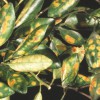 Since mineral nutrition is a major factor in maximizing yield of high quality fruit, understanding the functions of mineral elements, diagnosing nutrient deficiencies, and providing needed fertilizers are essential. This publication describes and discusses molybdenum (Mo) and nickel (Ni) deficiencies, functions, and recommended practices to alleviate nutritional problems.This 3-page fact sheet was written by Mongi Zekri and Tom Obreza , and published by the UF Department of Soil and Water Science, March 2014.
Since mineral nutrition is a major factor in maximizing yield of high quality fruit, understanding the functions of mineral elements, diagnosing nutrient deficiencies, and providing needed fertilizers are essential. This publication describes and discusses molybdenum (Mo) and nickel (Ni) deficiencies, functions, and recommended practices to alleviate nutritional problems.This 3-page fact sheet was written by Mongi Zekri and Tom Obreza , and published by the UF Department of Soil and Water Science, March 2014.
http://edis.ifas.ufl.edu/ss618
Iron (Fe) and Copper (Cu) for Citrus Trees
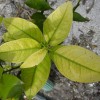 Since mineral nutrition is a major factor in maximizing yield of high-quality fruit, understanding the functions of mineral elements, diagnosing nutrient deficiencies, and providing needed fertilizers are essential. This publication describes and discusses iron (Fe) and copper (Cu) deficiencies, functions, and recommended practices to alleviate nutritional problems. This 7-page fact sheet was written by Mongi Zekri and Tom Obreza, and published by the UF Department of Soil and Water Science, March 2014.
Since mineral nutrition is a major factor in maximizing yield of high-quality fruit, understanding the functions of mineral elements, diagnosing nutrient deficiencies, and providing needed fertilizers are essential. This publication describes and discusses iron (Fe) and copper (Cu) deficiencies, functions, and recommended practices to alleviate nutritional problems. This 7-page fact sheet was written by Mongi Zekri and Tom Obreza, and published by the UF Department of Soil and Water Science, March 2014.
http://edis.ifas.ufl.edu/ss617
Manganese (Mn) and Zinc (Zn) for Citrus Trees
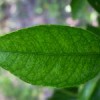 Since mineral nutrition is a major factor in maximizing yield of high-quality fruit, understanding the functions of mineral elements, diagnosing nutrient deficiencies, and providing needed fertilizers are essential. This publication describes and discusses manganese (Mn) and zinc (Zn) deficiencies, functions, and recommended practices to alleviate nutritional problems. This 5-page fact sheet was written by Mongi Zekri and Tom Obreza , and published by the UF Department of Soil and Water Science, March 2014.
Since mineral nutrition is a major factor in maximizing yield of high-quality fruit, understanding the functions of mineral elements, diagnosing nutrient deficiencies, and providing needed fertilizers are essential. This publication describes and discusses manganese (Mn) and zinc (Zn) deficiencies, functions, and recommended practices to alleviate nutritional problems. This 5-page fact sheet was written by Mongi Zekri and Tom Obreza , and published by the UF Department of Soil and Water Science, March 2014.
http://edis.ifas.ufl.edu/ss616
Calcium (Ca) and Sulfur (S) for Citrus Trees
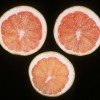 Calcium and sulfur are sometimes called secondary nutrients. This term does not mean that these nutrients play a secondary role in citrus plant growth and development. Ca and S are as essential as N, P, K, Mg, and other nutrients for healthy plant growth. An inadequate supply of Ca and/or S can be a major constraint to crop production and quality. This 5-page fact sheet was written by Mongi Zekri and Tom Obreza, and published by the UF Department of Soil and Water Science, July 2013.
Calcium and sulfur are sometimes called secondary nutrients. This term does not mean that these nutrients play a secondary role in citrus plant growth and development. Ca and S are as essential as N, P, K, Mg, and other nutrients for healthy plant growth. An inadequate supply of Ca and/or S can be a major constraint to crop production and quality. This 5-page fact sheet was written by Mongi Zekri and Tom Obreza, and published by the UF Department of Soil and Water Science, July 2013.
http://edis.ifas.ufl.edu/ss584
Potassium (K) for Citrus Trees
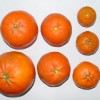 Citrus fruits remove large amounts of K compared to other nutrients. Potassium moves from leaves to fruit and seeds as they develop. Potassium is necessary for several basic physiological functions such as the formation of sugars and starch, synthesis of proteins, normal cell division and growth, and neutralization of organic acids. Potassium is important in fruit formation and enhances fruit size, flavor, and color. This nutrient also helps to reduce the influence that adverse weather conditions (such as drought, cold, and flooding) have on citrus trees. This 4-page fact sheet was written by Mongi Zekri and Tom Obreza, and published by the UF Department of Soil and Water Science, July 2013.
Citrus fruits remove large amounts of K compared to other nutrients. Potassium moves from leaves to fruit and seeds as they develop. Potassium is necessary for several basic physiological functions such as the formation of sugars and starch, synthesis of proteins, normal cell division and growth, and neutralization of organic acids. Potassium is important in fruit formation and enhances fruit size, flavor, and color. This nutrient also helps to reduce the influence that adverse weather conditions (such as drought, cold, and flooding) have on citrus trees. This 4-page fact sheet was written by Mongi Zekri and Tom Obreza, and published by the UF Department of Soil and Water Science, July 2013.
http://edis.ifas.ufl.edu/ss583
Phosphorus (P) for Citrus Trees
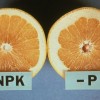 Phosphorus deficiency is not common in Florida citrus groves. If it does occur, it is more difficult to diagnose than nitrogen (N) deficiency or other nutrient element deficiencies. Growth is reduced when P supply is too low. Phosphorus is highly mobile in plants, so when it is deficient, it may move from old leaves to young leaves and other actively growing areas where energy is needed to form seeds and fruit. This 4-page fact sheet was written by Mongi Zekri and Tom Obreza, and published by the UF Department of Soil and Water Science, July 2013.
Phosphorus deficiency is not common in Florida citrus groves. If it does occur, it is more difficult to diagnose than nitrogen (N) deficiency or other nutrient element deficiencies. Growth is reduced when P supply is too low. Phosphorus is highly mobile in plants, so when it is deficient, it may move from old leaves to young leaves and other actively growing areas where energy is needed to form seeds and fruit. This 4-page fact sheet was written by Mongi Zekri and Tom Obreza, and published by the UF Department of Soil and Water Science, July 2013.
http://edis.ifas.ufl.edu/ss581
Magnesium (Mg) for Citrus Trees
 Magnesium deficiency has been a major problem in citrus production. In Florida, Mg deficiency is commonly referred to as “bronzing.” Trees with inadequate Mg may have no symptoms in the spring growth flush, but leaf symptoms develop as the leaves age and the fruit expand and mature in the summer and fall. Magnesium deficiency symptoms occur on mature leaves following the removal of Mg to satisfy fruit requirements. This 4-page fact sheet was written by Mongi Zekri and Tom Obreza, and published by the UF Department of Soil and Water Science, July 2013.
Magnesium deficiency has been a major problem in citrus production. In Florida, Mg deficiency is commonly referred to as “bronzing.” Trees with inadequate Mg may have no symptoms in the spring growth flush, but leaf symptoms develop as the leaves age and the fruit expand and mature in the summer and fall. Magnesium deficiency symptoms occur on mature leaves following the removal of Mg to satisfy fruit requirements. This 4-page fact sheet was written by Mongi Zekri and Tom Obreza, and published by the UF Department of Soil and Water Science, July 2013.
http://edis.ifas.ufl.edu/ss582
Nitrogen (N) for Citrus Trees
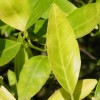 Nitrogen is the key component in mineral fertilizers applied to citrus groves. N has more influence on tree growth, appearance, and fruit production/quality than any other mineral element. Nitrogen affects the absorption and distribution of practically all other elements, and it is particularly important to the tree during flowering and fruit set. This 3-page fact sheet was written by Mongi Zekri and Tom Obreza, and published by the UF Department of Soil and Water Science, July 2013.
Nitrogen is the key component in mineral fertilizers applied to citrus groves. N has more influence on tree growth, appearance, and fruit production/quality than any other mineral element. Nitrogen affects the absorption and distribution of practically all other elements, and it is particularly important to the tree during flowering and fruit set. This 3-page fact sheet was written by Mongi Zekri and Tom Obreza, and published by the UF Department of Soil and Water Science, July 2013.
http://edis.ifas.ufl.edu/ss580
Watersheds of Florida: Understanding a Watershed Approach to Water Management (SL367/SS568)
 Water is of primary importance to all life on earth. Freshwater is a finite resource, and managing freshwater requires an understanding of watersheds and a watershed approach. Both quantity and quality of water are important for balanced beneficial and efficient agricultural, industrial, rural, and urban uses. This 7-page fact sheet provides information on watersheds and introduces the watershed approach and management concept as practiced in the U.S., with a focus on Florida watersheds in particular. This document also provides information on the basins, basin groups, and hydrologic units of Florida used by the Florida Department of Environmental Protection (FDEP) to implement watershed assessment, monitoring, and restoration programs. Written by Rao Mylavarapu, Kelley Hines, Thomas Obreza, and Greg Means, and published by the UF Department of Soil and Water Science, July 2012.
Water is of primary importance to all life on earth. Freshwater is a finite resource, and managing freshwater requires an understanding of watersheds and a watershed approach. Both quantity and quality of water are important for balanced beneficial and efficient agricultural, industrial, rural, and urban uses. This 7-page fact sheet provides information on watersheds and introduces the watershed approach and management concept as practiced in the U.S., with a focus on Florida watersheds in particular. This document also provides information on the basins, basin groups, and hydrologic units of Florida used by the Florida Department of Environmental Protection (FDEP) to implement watershed assessment, monitoring, and restoration programs. Written by Rao Mylavarapu, Kelley Hines, Thomas Obreza, and Greg Means, and published by the UF Department of Soil and Water Science, July 2012.
http://edis.ifas.ufl.edu/ss568
How to Characterize Soil Variability in Florida Citrus Groves as It Relates to Tree Growth and Yield (SL556/SS557)
 Non-uniform tree growth and fruit yield are very common throughout many Florida citrus groves, but variable groves are typically managed as if they were uniform. This 4-page fact sheet provides information about the relationship between soil variability and citrus production, proposes recommendations for soil sampling that account for spatial variability, and suggests site-specific management practices for variable Florida citrus groves. Written by Kirandeep K. Mann, Arnold W. Schumann, Thomas A. Obreza, Willie G. Harris, and Jerry B. Sartain, and published by the UF Department of Soil and Water Science, January 2011.
Non-uniform tree growth and fruit yield are very common throughout many Florida citrus groves, but variable groves are typically managed as if they were uniform. This 4-page fact sheet provides information about the relationship between soil variability and citrus production, proposes recommendations for soil sampling that account for spatial variability, and suggests site-specific management practices for variable Florida citrus groves. Written by Kirandeep K. Mann, Arnold W. Schumann, Thomas A. Obreza, Willie G. Harris, and Jerry B. Sartain, and published by the UF Department of Soil and Water Science, January 2011.
http://edis.ifas.ufl.edu/ss557
